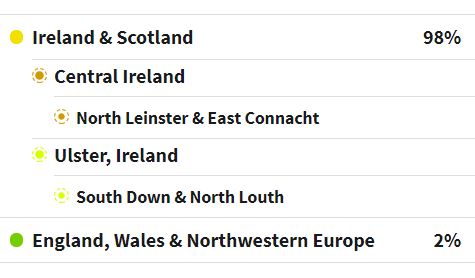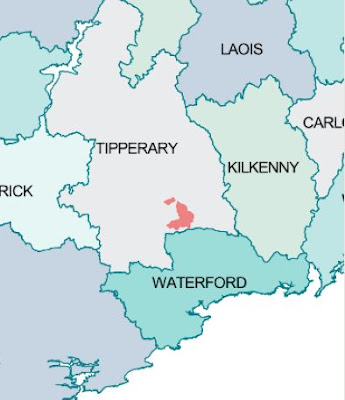In my post this week I'm looking at all the information I've uncovered along the way, but using a slightly different lens. I'm hoping I'll be able to pinpoint a little more clearly exactly where in the old country by Irish roots began.
My ethnicity map has changed
ever so slightly over the last year ...
... less of the English and just a tad more of the Irish - from areas within the regions of
Central Ireland and Ulster to be precise.
So far, I know that on my paternal side, my direct Irish ancestors have these surnames: Conners/Connors, Hickey, Farley or Farlane, and Cusack. I've found records back to my 3x great grandparents for most of these ancestors (born in the late 1790s-1800), apart from the Hickeys which I've managed to track back to my 4x great grandparents (born in the early 1770s-1780s).
(The other direct paternal ancestors come from Kent, Lincolnshire, Cornwall and Cumbria, with the records for these lines stretching back into the 1600s and 1700s)
On my maternal side, my direct Irish ancestors have these surnames: O'Donnell (Daniel), Joy, Burke/Bourke, Crotty, Muckian (McCane), McCann, Farrell, Downey/Muldowney. Records for these ancestors reach back to 3x great grandparents (born from the late 1780s to early 1800s), apart from the O'Donnells/Daniels which go back to 4x great grandparents (born in the mid 1700s).
Having now researched my direct Irish ancestors as far back as records will
allow at this point, I've ticked the counties that I know are the birthplaces for these people, and I wanted to check this against the information gleaned from my DNA
results.
 |
| Map showing birthplaces of direct ancestors |
 |
| Map showing the major regions of Ireland - Ulster, Connaught (Connacht), Leinster and Munster |
How does all this information match up?
My ethnicity estimate shows that some of my direct Irish ancestors came from
...
- The region of Ulster, Ireland - specifically the South Down and North Louth area.
The area is highlighted on this map in light, bright green (bottom right).
Looking at the previous map, you can see that I definitely have direct
ancestors who were born and lived in County Armagh, and part of that county
is located within the South Down and North Louth area.
County Armagh:
All these direct ancestors were born in the Catholic Parish of Killeavy,
County Armagh.
Sarah McCann, my 2nd great grandmother
Patrick Muckian, my 2nd great grandfather
and their son,
Owen McCane (Muckian), my great grandfather, was born in Ballintemple.
Great! There's a definite match-up there!
Now onto the other part of my ethnicity estimate ...
- Central Ireland - specifically the North Leinster and East Connacht area.
Within the region of Central Ireland, my connections are specifically
through direct ancestors linked to the North Leinster and East Connacht
area, highlighted in light orange on this map.
The North Leinster and East Connacht area would include the Counties of
Leitrim, Cavan, Meath, and parts of other Counties including Fermanagh, Longford,
Westmeath and
Roscommon.
Having now researched back on both my maternal and paternal Irish sides, as
far as records will allow, I find evidence of very few direct ancestors who
were actually born in these counties, apart from:
County Leitrim:
Michael Farrell, my 2x great grandfather, who was born in the Catholic Parish of
Kiltoghart; and
County Roscommon:
Susan Downey/Muldowney, my 2x great grandmother, who was born somewhere in County Roscommon
(still not definitively identified).
I have one ancestor who was born in King's County as it was known then (County Offaly) and that would be part of the darker orange section of Central Ireland. The county of Offaly would be part of the Leinster area, so that's another connection that relates to the orange shading.
County Offaly:
William Connors, my 2x great grandfather, was born in the Civil Parish of Gallen in King's County, later known as County Offaly.
Looking at my first map again however, you can see that the majority of my
direct Irish ancestors were born in counties further south of the North Leinster and East Connacht area. They were born and lived in the South Leinster and oarts of the Munster region.
County Limerick:
Patrick Cusack, my 2x great grandfather, was born in Askeaton.
Ellen Hickey, my 2x great grandmother, was born in Parteen.
County Kilkenny:
John O'Donnell, my 2x great grandfather, was born in Ballyhenebry.
Catherine Joy, my 2x great grandmother, was born in the Catholic Parish of Templeorum.
Edmond O'Donnell, my great grandfather, was born in Killonerry.
County Tipperary:
James Burke, my 2x great grandfather, was born in Clonmel in the Catholic Parish of
Powerstown.
County Waterford:
Catherine Crotty, my 2x great grandmother, was born in the Catholic Parish of Tramore.
Bridget Burke, my great grandmother, was born in Three Bridges.
What does this mean?
I'm assuming it means that my direct ancestors listed above were likely to have been descendants of family that were born elsewhere, perhaps in the North Leinster and East Connacht region, and then at some point those unknown ancestors moved south, into the South Leinster area and Munster
region. It will be difficult to prove this, as Irish records before the
1800s are very few and far between, so this assumption will likely remain
unproven.
I've been lucky enough, after several trips to Ireland, to get close to all the birthplaces of my direct Irish ancestors and capture some memorable vistas. Using landscape photos I personally shot and precious photos of my ancestors (or other photos if I don't have one of an ancestor), I've created collages of these people and the areas they came from.
County Armagh: Owen McCane (Muckian), my maternal great grandfather,
County Leitrim: Michael Farrell, my maternal 2x great grandfather.
County Roscommon: Susan Downey/Muldowney, my maternal 2x great grandmother (Michael Farrell's wife).
County Limerick: Patrick Cusack, my paternal 2x great grandfather,
Ellen Hickey, my paternal 2x great grandmother.
County Kilkenny: Edmond O'Donnell, my maternal great grandfather,
and his parents, John O'Donnell and Catherine Joy, my maternal 2x great grandparents.
County Tipperary: James Burke, my maternal 2x great grandfather.
County Waterford: Bridget Burke, my maternal great grandmother (daughter of James Burke).
Catherine Crotty, my maternal 2x great grandmother.
County Offaly (King's County): William Connors, my paternal 2x great grandfather.















































